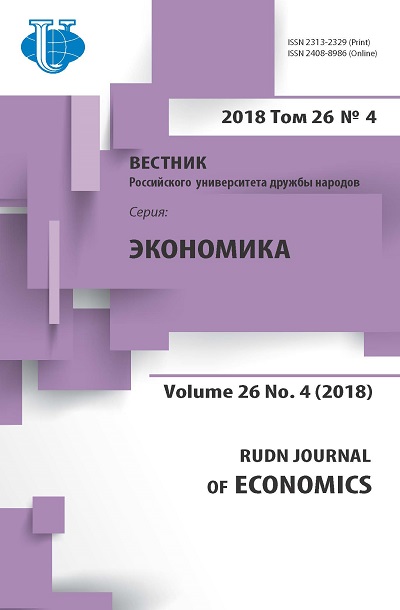Evolution of the spatial structure of the urban system of settlement in the coastal zones of European Russia
- Authors: Sukhinin S.A1
-
Affiliations:
- Don State Technical University
- Issue: Vol 26, No 4 (2018)
- Pages: 653-661
- Section: REGIONAL ECONOMY
- URL: https://journals.rudn.ru/economics/article/view/20758
- DOI: https://doi.org/10.22363/2313-2329-2018-26-4-653-661
Cite item
Full Text
Abstract
The study of the development of settlement systems has traditionally been included in sphere of public geography and regional economics. Based on statistical material, the author characterizes the urban system of settlement in coastal zones of European part of Russia. The author analyzes the structural differences between the Northern and Southern coastal macrozones, the features of cities location and their functional specialization. Is emphasized the role of “sea factor” in the history of origin and development, the dynamics of population of coastal cities. The author shows the dominant influence of demographic, socio-economic and administrative factors on evolution of spatial structure on the urban settlement system in the coastal zones of European Russia in recent decades. Conclusions are drawn about polarization of the urban settlement system in direction of population concentration in urban agglomerations and strengthening of their role in social and economic development.
About the authors
Sergey A Sukhinin
Don State Technical University
Author for correspondence.
Email: suhmax@mail.ru
Candidate of Pedagogical Sciences, Associate Professor, Department of Economic Theory and Entrepreneurship, Academy of Construction and Architecture, Don State Technical University (DSTU).
1 Gagarin Sq., Rostov-on-Don, 344000, Russian FederationReferences
- Gogoberidze G.G. (2007). Kompleksnoe raionirovanie primorskikh territorii Mirovogo okeana. Saint Petersburg: RSHU Publ. 396 p.
- Lappo G.M. (1997). Geografiya gorodov. Moscow: Vlados Publ. 480 p.
- Mechnikov L.I. (1995). Tsivilizatsiya i velikie istoricheskie reki. Moscow: Pangea Publ. 461 p.
- Mironova M.N. (2011). Management of regional development in Russia: main trends of modern regional policy. RUDN Journal of Economics. No. S5. Pp. 185—195.
- Mironova M.N., Kholina V.N. (2011). Regional disparities in Russia: dynamics in the post-soviet period. RUDN Journal of Economics. No. 4. Pp. 23—34.
- Pokshishevsky V.V. (1979). Geografiya rasseleniya na beregakh Mirovogo okeana. Leningrad: Nauka Publ. 342 p.
- Pokshishevsky V.V., Fedorov G.M. (1988). Osnovy geografii naseleniya i rasseleniya v predelakh Mirovogo okeana. Geografiya okeana: teoriya, praktika, problemy. Slevich S.B. (ed.). Leningrad: Nauka Publ. Pp. 148—161.
- Rosstat. (2016). Regiony Rossii. Osnovnye sotsial’no-ekonomicheskie pokazateli gorodov. Moscow. 442 p.
- Rosstat. (2017). Regiony Rossii. Sotsial’no-ekonomicheskie pokazateli. Moscow. 1402 p.
- Sotsial’no-ekonomicheskoye razvitiye primorskikh territoriy Yevropeyskoy chasti Rossii: faktory, trendy, modeli. (2016). Druzhinin A.G. (ed.). Rostov-on-Don: Southern Federal University Publ. 236 p.
- Transgranichnoe klasteroobrazovanie v primorskikh zonakh Evropeiskoi chasti Rossii: faktory, modeli, ekonomicheskie i ekisticheskie effekty. (2017). Druzhinina A.G. (ed.). Rostov-on-Don: Southern Federal University Publ. 421 p.
- Chistyakov V.I., Filobok A.A. (2008). Ustoichivoe razvitie gorodov Azovo-Chernomorskogo poberezh’ya Rossii v novykh geoekonomicheskikh usloviyakh. Krasnodar: Prosveshchenie-Yug Publ. 308 p.
- Baklanov P.Y., Novikov A.N., Ptitsyn A.B. (2016). Structural and geographical analysis of cross-border three-member areas. Doklady Earth Sciences. Vol. 468. No. 1. Pp. 493—495.
- Bezrukov L.A. (2008). Role of the continental-oceanic dichotomy in the territorial price and income differentiation. Geography and Natural Resources. Vol. 29. No. 4. Pp. 321—329. doi: 10.1016/j. gnr.2008.10.014.
- Druzhinin A.G. (2016). “Maritime” component in the Russian human geography: traditions and novations. Izvestiya Rossiiskoi akademii nauk. Seriya Geograficheskaya. No. 6. Pp. 7—16. doi: 10.15356/0373-2444-2016-6-7-16
- Fedorov G.M., Kuznetsova T.Y., Razumovskii V.M. (2017). How the proximity of the sea affects development of economy and the settlement pattern in Kaliningrad oblast. Regional Research of Russia. Vol. 7. No. 4. Pp. 352—362. doi: 10.1134/s2079970517040025















